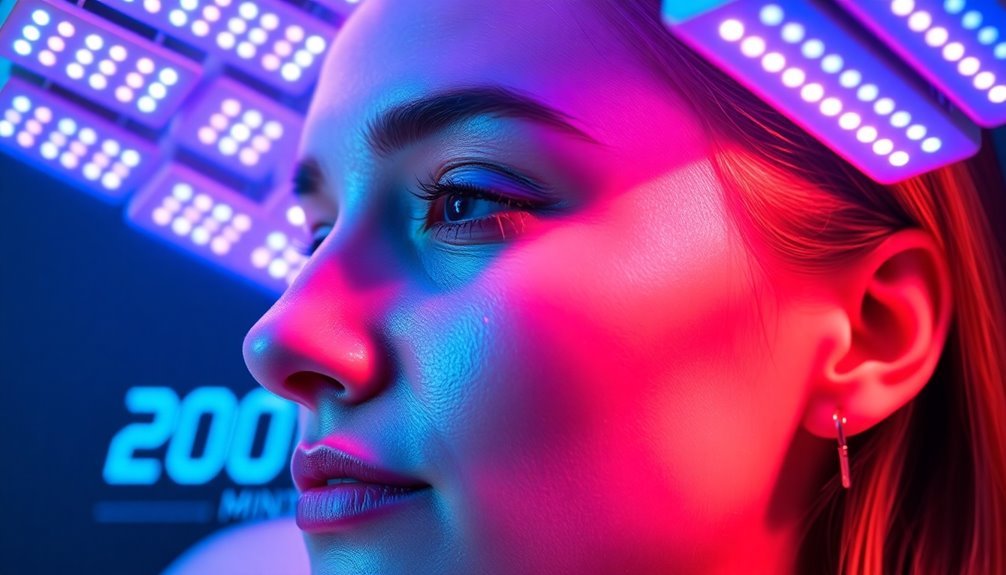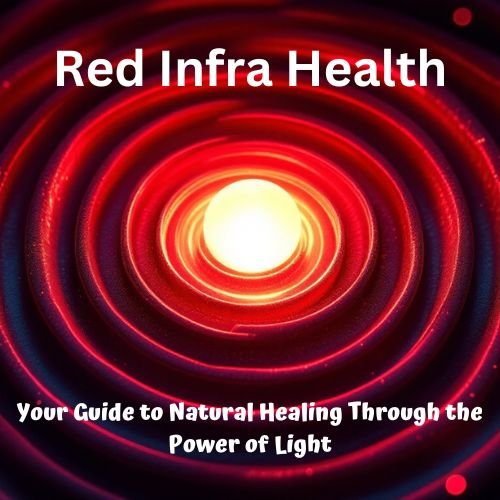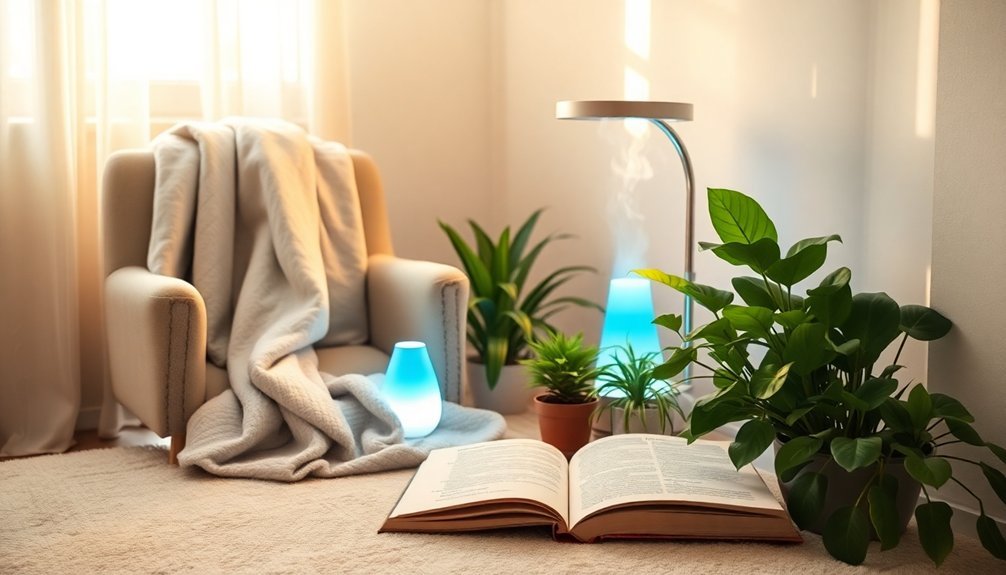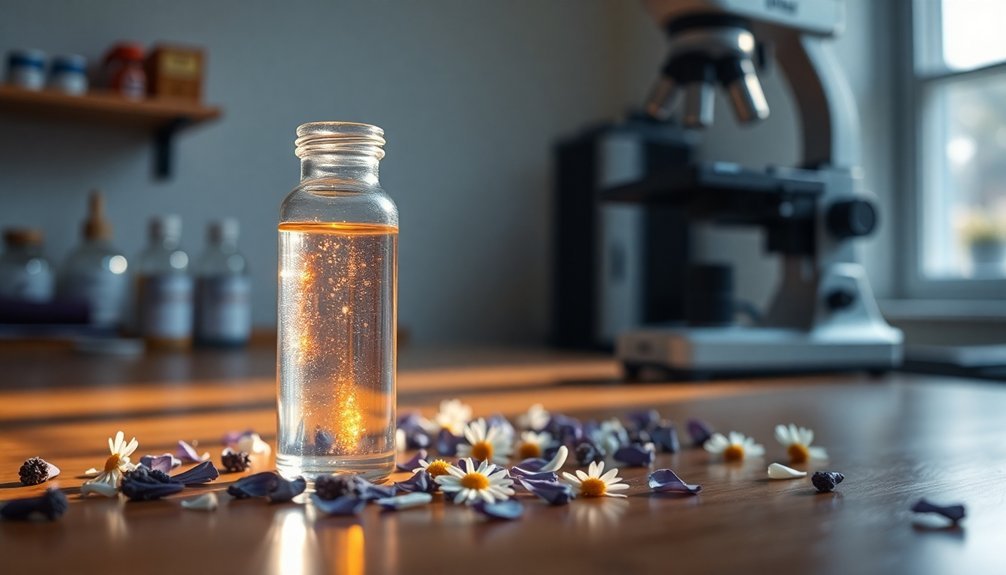LED light therapy offers 7 powerful treatments to smooth your wrinkled skin: red light (660nm) stimulates collagen production, near-infrared light (780-980nm) enhances cellular repair, and combining both maximizes anti-aging effects. You'll get the best results by using blue light to reduce inflammation, yellow light to promote healing, and alternating between 15-30 minute sessions 2-3 times weekly. For ideal results, pair LED treatments with vitamin C and retinol products, and maintain a consistent schedule. While at-home devices work well, professional treatments can provide deeper penetration. The journey to smoother, younger-looking skin has only just begun.
Understanding LED Light Therapy Basics

In the world of skincare innovation, LED light therapy stands out as a breakthrough treatment for aging skin. This non-invasive treatment uses light-emitting diodes to deliver specific wavelengths of light that penetrate your skin at various depths, stimulating natural healing and rejuvenation processes.
You'll find LED therapy available in two primary forms: professional treatments at clinics and at-home LED masks. While both options can be effective, professional devices typically deliver more powerful results. Each session typically requires 15-30 minutes of exposure under specialized light screens.
The therapy works by using different colored lights to target specific skin concerns – red light stimulates collagen production, blue light fights acne-causing bacteria, and yellow light promotes healing.
When you undergo LED therapy, you're engaging in a painless process that fuels the repair of damaged skin cells. The light energy boosts circulation and accelerates tissue repair, making it an excellent choice for addressing wrinkles and other signs of aging.
You'll likely need multiple sessions to achieve noticeable results, and maintenance treatments may be necessary to preserve your improvements. While the therapy is generally safe, you should wear protective goggles and consult a dermatologist before starting treatment, especially if you have sensitive skin or take certain medications.
Red Light Benefits For Aging
Among the various LED light colors used in skin therapy, red light emerges as the powerhouse for addressing aging concerns. When you expose your skin to red LED wavelengths, particularly at 660 nm, you'll trigger powerful cellular responses that combat the visible signs of aging.
Clinical studies have shown impressive results, with 91% of participants noting improved skin tone and 82% experiencing enhanced smoothness. The gentle treatment eliminates UV damage while promoting healing.
The science behind red light's effectiveness lies in its ability to penetrate your skin's layers and stimulate essential biological processes. You'll benefit from increased collagen production, as red light activates your skin's fibroblasts – the cells responsible for creating new collagen and elastin fibers. This boost in collagen leads to measurable improvements, including up to 36% reduction in wrinkles and 19% increase in skin elasticity.
- Enhances blood circulation between blood and tissue cells, promoting natural skin rejuvenation
- Increases cellular energy production through improved mitochondrial activity
- Reverses collagen breakdown while reducing inflammation and fine lines
These benefits aren't just temporary – with regular treatments following proper guidelines, you'll experience lasting improvements in your skin's texture, firmness, and overall appearance.
Near-Infrared Light Penetration Depths

Delving into near-infrared (NIR) light reveals impressive penetration capabilities that surpass visible red light therapy. While red light wavelengths (600-700nm) penetrate up to 1mm into your skin, NIR wavelengths (780-980nm) can reach depths of up to 2.5mm, making them particularly effective for targeting deeper tissue layers. Continuous wave delivery provides optimal penetration compared to pulsed treatments.
You'll achieve the best results when the LED device makes direct contact with your skin, as this substantially reduces light loss from reflection and refraction. The wavelength you choose matters – longer wavelengths like 850nm and 900nm penetrate deeper than shorter ones, reaching up to 2.4mm and 2.5mm respectively.
What makes NIR so effective is its ability to bypass common absorption barriers like melanin, hemoglobin, and water within an ideal "optical window." This deeper penetration enables NIR to stimulate cellular energy production and enhance ATP levels in deeper tissue layers.
You'll benefit from both surface-level improvements and deeper therapeutic effects, from collagen stimulation to muscle recovery. However, it's crucial to note that some NIR wavelengths can create thermal effects, so using filtered wavelengths helps deliver benefits without excessive heating.
Daily Treatment Protocols
You'll want to begin your LED treatment program with 10-minute daily sessions for the first two weeks, gradually increasing to 15-20 minutes as your skin adapts.
For best anti-aging results, schedule your treatments 3-4 times a week, spacing them at least 24 hours apart to allow for proper cellular regeneration.
At-home LED therapy works best when you maintain a consistent schedule, ideally using your device at the same time each day and following manufacturer guidelines for maximum session duration. Always wear protective goggles during treatment to prevent potential eye damage from the LED lights.
Optimal Treatment Duration Times
The ideal duration for LED skin treatments follows a precise balance between session length and frequency. Most sessions should last between 10-30 minutes, with 20 minutes being the sweet spot for best results. Since LED light therapy is pain-free and non-invasive, you can comfortably complete your full session time.
You'll need to adjust your treatment time based on factors like the size of the treatment area and your skin's specific needs.
- For anti-aging treatments, aim for 3-5 weekly sessions of 20 minutes each
- If you're using higher intensity devices, you can reduce session frequency
- When treating larger areas, extend sessions to 25-30 minutes for complete coverage
Your treatment duration should align with your skin concerns and schedule. For instance, if you're targeting wrinkles, you'll want to maintain consistency with regular 20-minute sessions. As your skin improves, you can move to a maintenance phase of 2-3 sessions weekly.
If you're new to LED therapy, start with shorter sessions and gradually increase duration as your skin adapts. Remember to always follow your device's specific guidelines, as treatment times can vary based on the light intensity and wavelengths used in different devices.
At-Home Program Guidelines
Now that you understand ideal treatment timing, establishing a proper at-home LED protocol will maximize your results. Start by thoroughly cleansing your face with a gentle, soap-free cleanser, performing a double cleanse if needed.
Don't apply any topical products before your treatment, as this guarantees maximum light penetration into your skin. Keep your LED device fully charged or plugged before starting your session.
Position your LED device within one inch of your face, and always wear the protective eyewear provided by the manufacturer. Select the appropriate light mode for your specific skin concerns – red light targets wrinkles, while blue light addresses acne.
You'll want to maintain each treatment session for 15-30 minutes, following your device's specific guidelines for timing and distance.
After treatment, apply your serums and moisturizers to enhance the benefits. Focus on products containing vitamin C, hyaluronic acid, and growth factors. Don't forget to apply sunscreen for daytime protection.
Track your progress by taking regular photos of your skin's improvement. Stay consistent with your routine, but monitor your skin's reaction carefully. If you experience any unusual redness or irritation, adjust your treatment time or frequency, and consult a professional if concerns arise.
Weekly Session Frequency Plan
Establishing an effective LED treatment schedule requires careful planning and consistency to achieve the best results. For wrinkled skin concerns, you'll want to start with sessions spaced 1-2 weeks apart during the initial phase to stimulate collagen and elastin production effectively.
As you progress, you can adjust your treatment frequency based on how your skin responds and the specific LED device you're using. The therapy uses red and near-infrared wavelengths to penetrate deeply into the skin layers for optimal rejuvenation.
- During weeks 1-4: Schedule 2-3 sessions per week to jumpstart your skin's renewal process.
- Weeks 5-8: Reduce to 1-2 sessions weekly as your skin adapts to the treatment.
- Maintenance phase: Continue with 1 session every 1-2 weeks to maintain results.
You'll need to commit to regular sessions to see maximum improvements in your wrinkles and fine lines. If you're using an at-home LED device, you can maintain a more frequent schedule than with professional treatments. Remember to monitor your skin's response and adjust accordingly.
For enhanced results, combine your LED sessions with a consistent skincare routine and protect your skin from sun damage between treatments.
Combining LED Colors For Results

When you combine red and blue LED lights, you'll target both aging concerns and acne while improving lymphatic flow and promoting relaxation.
You can maximize your treatment results through strategic multi-wave therapy, as different wavelengths work together to enhance overall skin benefits. The addition of yellow light to this combination speeds wound healing and reduces post-treatment swelling.
Red Plus Blue Benefits
Combining red and blue LED light therapy delivers a powerful one-two punch against multiple skin concerns, from wrinkles to acne. While red light penetrates deeply to boost collagen production and enhance skin elasticity, blue light works on the surface to combat acne-causing bacteria and reduce oil production. Together, they create a thorough treatment that addresses both aging and breakouts simultaneously. Clinical research has shown that this dual wavelength approach provides superior results compared to single-color treatments.
- Red light stimulates collagen and elastin production, reducing fine lines and wrinkles while improving skin firmness
- Blue light targets sebaceous glands and kills acne-causing bacteria, leading to clearer skin
- The combination reduces inflammation, speeds healing, and promotes even skin tone
You'll notice improved skin texture and tone as the dual wavelengths work synergistically. The red light increases circulation and promotes cellular turnover, while also boosting hyaluronic acid production for better hydration.
Meanwhile, the blue light helps minimize pore size and control oil production. This powerful combination also helps fade dark spots and reduce hyperpigmentation, leaving your skin looking smoother and more radiant.
If you're dealing with both aging concerns and occasional breakouts, this dual-therapy approach offers an efficient solution for achieving healthier, clearer skin.
Multi-Wave Treatment Synergy
The synergistic power of multi-wave LED therapy delivers enhanced results that single-wavelength treatments can't match. When you combine red and near-infrared light, you'll target both superficial wrinkles and deeper dermal layers, stimulating thorough collagen production throughout your skin.
With a treatment area of 50cm × 20cm, this advanced LED system ensures comprehensive coverage for full-face and neck treatments. You'll see particularly impressive results when combining specific wavelengths. Red and amber light (590-620 nm) work together to boost fibroblast activity, reducing fine lines while improving skin texture.
If you're dealing with both aging and acne concerns, the blue and red light combination offers dual benefits – blue light eliminates acne-causing bacteria while red light promotes collagen synthesis.
Clinical findings show these multi-wave approaches are remarkably effective. Up to 45% of patients experience significant wrinkle reduction with red light therapy, while 90% see noticeable improvements in pore size.
The treatment penetrates at different depths – red light targets surface concerns while infrared reaches deeper layers where collagen and elastin form. You'll benefit from improved skin firmness, reduced UV damage, and enhanced skin clarity.
Touch-pad systems now make it easy to customize your treatment with various light frequencies for ideal results.
Strategic Light Color Combinations
Building on the success of multi-wave treatments, specific LED color pairings offer targeted solutions for various skin concerns. By strategically combining different wavelengths, you'll maximize the benefits of LED therapy for your skin.
The red and amber combination enhances collagen production while boosting cellular metabolism, making it particularly effective for addressing wrinkles and improving overall skin texture.
- Red + Infrared: Penetrates deeply to stimulate collagen production and enhance cellular repair while improving circulation
- Blue + Green: Targets acne-causing bacteria and reduces inflammation while evening out skin tone
- Red + Amber: Promotes skin rejuvenation through enhanced collagen synthesis and improved cellular metabolism
When you're dealing with multiple skin concerns, combining wavelengths can provide thorough results. Blue and green lights work together to calm inflammation and reduce pigmentation, while red and infrared penetrate at different depths to promote healing and rejuvenation.
For the best results, you'll want to choose combinations that specifically target your skin concerns. Professional LED devices often incorporate multiple wavelengths, allowing you to customize your treatment based on your specific needs.
Professional Vs Home LED Devices
Modern LED light therapy presents consumers with two distinct paths: professional treatments at clinics and at-home devices for personal use. Professional devices boast higher intensity with more LEDs, deeper cellular penetration, and carefully calibrated treatment protocols. However, home devices offer convenience, flexibility, and cost-effectiveness for long-term skin care maintenance.
| Aspect | Professional LED | Home LED |
|---|---|---|
| Power | 770+ LEDs, higher intensity | Fewer LEDs, moderate intensity |
| Treatment | Supervised, pre-set protocols | Self-administered, flexible timing |
| Cost | Higher per session | One-time investment |
| Results | Immediate, dramatic effects | Gradual improvements |
| Support | Direct dermatological guidance | User manuals, online support |
You'll find professional treatments particularly beneficial if you're dealing with severe wrinkles or require intense therapy under expert supervision. These treatments utilize multiple wavelengths and clinical-grade power for ideal results. Meanwhile, if you're looking for consistent maintenance and have mild to moderate wrinkles, FDA-cleared home devices like the MMSphere can effectively complement your skincare routine. They're designed for safe, regular use and can target various skin concerns through different wavelength options.
Optimal Treatment Duration

When using LED treatments for wrinkled skin, you'll need to follow specific session guidelines of 10-20 minutes per treatment, depending on your device's power level and your skin's sensitivity.
Your weekly schedule should align with your device type, with low-power devices safe for daily use and high-power devices limited to 2-3 times per week.
You can optimize your results by maintaining a treatment log to monitor your progress and adjust your session duration as needed.
Daily Session Length Guidelines
Determining the right treatment duration for LED skin therapy is essential for achieving best results while avoiding potential irritation. Your device's power level will dictate how often you should use it.
For low-power devices (under 30mW/cm2), you can safely perform 10-30 minute sessions daily or twice daily. Medium-power devices (around 30mW/cm2) should be used every other day or daily, while high-power devices (60-120W/cm2) require less frequent sessions of just 2-3 times per week.
Key points to remember when planning your LED treatment schedule:
- Start with shorter sessions and gradually increase duration as your skin adapts
- Listen to your skin – if you notice irritation, reduce frequency or duration
- Maintain consistency with your chosen schedule for ideal results
Remember that more isn't always better with LED therapy. You'll want to find the sweet spot that works for your skin type and concerns. For wrinkle reduction, consistency is more important than intensity.
Even after you've achieved your desired results, continue with maintenance sessions to preserve your skin's improved appearance and health.
Weekly Treatment Schedule
Building on the importance of session length, establishing a weekly LED treatment schedule requires careful planning to maximize anti-aging benefits. For the best results, you'll want to schedule your LED sessions 1-2 weeks apart when targeting fine lines and wrinkles.
However, if you're just starting your anti-aging journey, you can accelerate initial results with more frequent sessions of 3-5 times per week to boost collagen production.
Your treatment frequency should align with your device's power level. If you're using a low-power LED device, you can safely perform daily treatments. Medium-power devices work well with every-other-day sessions, while high-power devices should be limited to 2-3 times weekly to prevent skin irritation. Remember, more isn't always better when it comes to LED therapy.
You'll need to maintain consistency in your schedule to see lasting results. Monitor how your skin responds and adjust accordingly. If you notice any irritation, reduce your session frequency.
For maintenance, once you've achieved your desired results, you can typically scale back to weekly treatments while still maintaining the benefits of your LED therapy.
Tracking Progress Over Time
Three key milestones mark the ideal duration for LED skin treatments. You'll typically notice initial improvements after 4-6 weeks of consistent use, but maintaining your results requires a long-term commitment.
For best results, you'll want to schedule 10-20 minute sessions, 2-3 times per week, adjusting the frequency based on your device's power levels.
Track your progress systematically to guarantee you're getting the most from your LED treatments:
- Take before and after photos under identical lighting conditions to document visible changes
- Keep a skincare diary noting treatment times, device settings, and skin reactions
- Monitor your progress weekly, making adjustments to frequency based on your skin's response
Your device's specifications will influence your treatment schedule. If you're using a low-power device (under 30mW/cm2), you can safely perform daily sessions. However, high-power devices (60-120W/cm2) should be limited to three times weekly.
Don't fall into the trap of overusing your device – more isn't always better. Instead, focus on consistency and patience, following the recommended guidelines for your specific skin concerns and device type.
Safety Measures During LED Sessions
Protecting yourself during LED light therapy requires careful attention to essential safety protocols. You'll need to wear protective goggles to shield your eyes from bright lights, and consult your doctor before starting treatment if you're pregnant, have epilepsy, or suffer from conditions like thyroid disorders or systemic lupus erythematosus.
| Safety Measure | Action Required |
|---|---|
| Eye Protection | Wear protective goggles during every session |
| Medications | Stop using photosensitizing medications |
| Recent Procedures | Wait 5 days after Botox or fillers |
| Skin Check | Monitor for redness or irritation |
| Treatment Timing | Follow recommended session durations |
If you've recently had cosmetic procedures, you'll need to wait five days before starting LED therapy. Don't skip device maintenance – it's vital for both safety and effectiveness. Watch for common side effects like mild redness or swelling, and stop treatment if you experience unusual reactions. You'll need to be particularly cautious if you have sensitive skin or pre-existing conditions. After each session, apply broad-spectrum sunscreen and avoid direct sun exposure for at least 12 hours. Remember to use gentle cleansers and let any serums absorb completely before your next treatment.
Tracking Your Skin Progress
With safety protocols in place, you'll want to monitor the effectiveness of your LED treatments carefully. Taking baseline photos before starting treatment is essential – make sure you capture images in consistent lighting conditions to track subtle improvements accurately.
You'll see the most noticeable changes in fine lines and wrinkles within several weeks to months of regular sessions.
- Use a combination of red and infrared light for ideal rejuvenation results
- Document any changes in your skincare routine to isolate LED therapy's effects
- Take weekly or monthly progress photos to track improvements systematically
To maximize your progress tracking, consider using objective measurement tools like SkinScope LED to identify underlying damage and monitor improvements. Clinical studies have shown that LED therapy stimulates collagen production and increases skin elasticity, but these changes occur gradually.
You'll need to maintain consistent treatment schedules and keep detailed records of any side effects or discomfort. Remember that different skin concerns require different timelines – while some issues might show improvement quickly, others may take longer to respond.
Long-Term Maintenance Strategies
Successful LED skin therapy depends on maintaining a well-structured, long-term routine. You'll need to commit to regular weekly or bi-weekly sessions to achieve and maintain your desired results. Consistency is essential – skipping treatments can slow down your progress and potentially lead to regression of improvements.
To maximize your long-term results, combine your LED treatments with complementary skincare products. Use hyaluronic acid, vitamin C, and retinol-based products to enhance the therapy's effects.
Make sure you're cleansing your skin thoroughly before each session and applying hydrating products afterward to support skin recovery and rejuvenation.
Consider working with a skincare professional who can monitor your progress and adjust your treatment plan as needed. They'll help determine the most effective combination of wavelengths for your specific skin concerns and guide you on treatment frequency. Your professional can also recommend when to increase or decrease session frequency based on your skin's response.
Remember to protect your eyes during every treatment and maintain detailed records of your sessions. This documentation helps track your progress and confirms you're staying on schedule with your maintenance routine.
Frequently Asked Questions
Can LED Treatments Help With Deep Expression Lines Around the Mouth?
Yes, you'll see improvement in deep mouth lines through LED therapy. It stimulates collagen production and improves skin texture. With regular treatments over 8-12 weeks, you'll notice smoother, firmer skin around your mouth.
Do LED Masks Work Effectively Through Facial Hair or Stubble?
You'll get reduced effectiveness when using LED masks through facial hair since it blocks and scatters light. For best results, you should consider dermaplaning or shaving before your LED treatment sessions.
Should LED Therapy Be Avoided Immediately After Getting Dermal Fillers?
Yes, you'll need to wait 2-3 days before using LED therapy after getting dermal fillers. This waiting period helps prevent any interference with the filler's settling process and reduces post-treatment inflammation.
How Does Seasonal Changes in Skin Affect LED Treatment Effectiveness?
Your skin's seasonal changes won't substantially impact LED therapy's effectiveness. You'll still get consistent results for improving skin tone and texture, though you may need to adjust treatment frequency based on your skin's needs.
Can LED Therapy Reverse Sun Damage Spots From Childhood?
Yes, you can treat childhood sun damage spots with LED therapy. It'll help reduce hyperpigmentation by targeting damaged cells and stimulating collagen production, though you may need multiple sessions for the best results.
In Summary
LED light therapy offers you a powerful path to smoother, younger-looking skin. You'll see the best results when you're consistent with your treatments and combine different wavelengths strategically. Start with short sessions, follow safety protocols, and track your progress with photos. If you maintain your routine and adjust treatments based on your skin's response, you'll enjoy lasting improvements in your skin's texture and appearance.





Leave a Reply